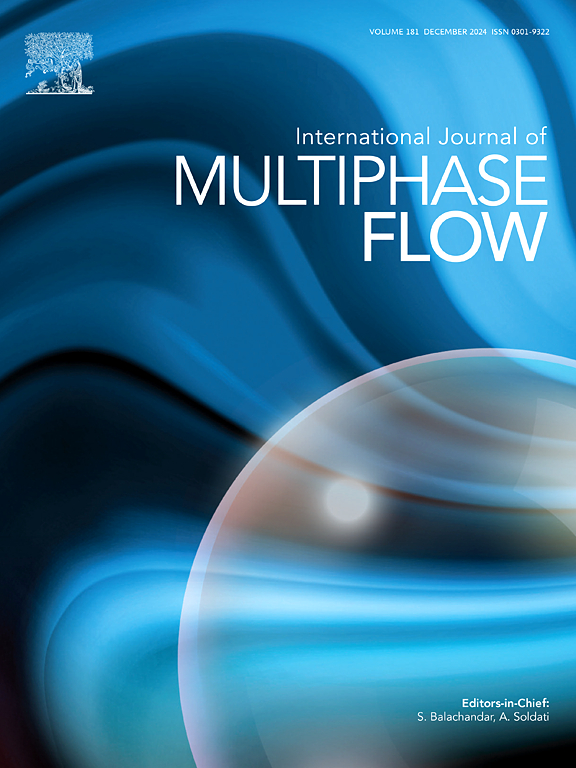Numerical investigation of particle transport and deposition mechanisms driven by multiphase explosion coupling with buffer gas stream
IF 3.8
2区 工程技术
Q1 MECHANICS
International Journal of Multiphase Flow
Pub Date : 2025-06-30
DOI:10.1016/j.ijmultiphaseflow.2025.105336
引用次数: 0
Abstract
Debris suppression and expulsion are among the key challenges in designing and optimizing the light source system of extreme ultraviolet lithography (EUVL). The mechanisms of debris transport and deposition still require further investigation. The study of this problem involves compressible gas-particle multiphase fluid dynamics. In this study, the transport, spatial distribution characteristics of debris particles, and the wall deposition mechanism within a rectangular cavity are investigated from the multiphase flow perspective by employing the compressible multiphase particle-in-cell (CMP-PIC) method. Our analysis reveals that particle transport encompasses the following processes: Firstly, multiple particle jets are induced due to shock-driven multiphase instability. Subsequently, the bending and coalescing process of particle jets are observed under the influence of vortex and buffer gas stream. Simultaneously, particles aggregate near the explosion center and are transported by the buffer gas stream. Furthermore, three distinct deposition mechanisms are identified for the first time, namely: (1) velocity-induced separation within the particle-buffer gas stream, (2) high-velocity particle jet impact, and (3) particle cluster transport driven by the buffer gas stream. Additionally, parametric study was conducted to evaluate the effect of particle diameter on the debris transport and deposition mechanism. Owing to variations of inertia and relaxation time, significant differences in the evolution, position distribution, and coalescing process are observed, which subsequently affect the deposition momentum of each wall and the emission ratio. Results indicate that smaller particles (dp=0.2 μm and dp=0.6 μm) exhibit shorter relaxation times, leading to enhanced expulsion by the buffer gas stream and reduced wall deposition momentum. Whereas larger particles (dp=1.0 μm and dp=2.0 μm) lag in evolution, weaken particle jet coalescing process, and increase wall deposition momentum due to its large inertia. Three-dimensional simulation results show that particle-buffer gas stream velocity separation and high-velocity particle impact mechanisms dominate particle distribution, while the influence of particle cluster formation and transport is significantly diminished. These findings on transport characteristics and deposition mechanism of particles provide valuable insights for optimizing EUVL source system.

多相爆炸耦合缓冲气流驱动下颗粒输运沉积机理的数值研究
碎片抑制和排屑是极紫外光刻(EUVL)光源系统设计和优化的关键问题之一。岩屑运移和沉积的机制仍需进一步研究。这一问题的研究涉及可压缩气粒多相流体力学。本文采用可压缩多相颗粒池(CMP-PIC)方法,从多相流的角度研究了矩形空腔内碎屑颗粒的输运、空间分布特征以及壁面沉积机理。我们的分析表明,粒子输运包括以下过程:首先,由于激波驱动的多相不稳定性导致了多粒子射流的产生。随后,在涡旋和缓冲气流的影响下,观察了粒子射流的弯曲和凝聚过程。同时,颗粒在爆炸中心附近聚集,并被缓冲气流输送。此外,首次确定了三种不同的沉积机制,即:(1)颗粒-缓冲气流内部的速度诱导分离,(2)高速颗粒射流撞击,以及(3)缓冲气流驱动的颗粒簇输运。此外,通过参数化研究,探讨了粒径对颗粒输运和沉积机理的影响。由于惯性和弛豫时间的变化,在演化、位置分布和聚结过程中观察到显著的差异,从而影响各壁的沉积动量和发射比。结果表明,dp=0.2 μm和dp=0.6 μm的小颗粒弛豫时间较短,导致缓冲气流的排出增强,壁面沉积动量减小。而大颗粒(dp=1.0 μm和dp=2.0 μm)由于惯性大,演化滞后,射流聚结过程减弱,壁面沉积动量增大。三维模拟结果表明,颗粒-缓冲气流速度分离和高速颗粒撞击机制主导了颗粒分布,而颗粒团簇形成和输运的影响明显减弱。这些研究结果为优化EUVL源系统提供了有价值的见解。
本文章由计算机程序翻译,如有差异,请以英文原文为准。
求助全文
约1分钟内获得全文
求助全文
来源期刊
CiteScore
7.30
自引率
10.50%
发文量
244
审稿时长
4 months
期刊介绍:
The International Journal of Multiphase Flow publishes analytical, numerical and experimental articles of lasting interest. The scope of the journal includes all aspects of mass, momentum and energy exchange phenomena among different phases such as occur in disperse flows, gas–liquid and liquid–liquid flows, flows in porous media, boiling, granular flows and others.
The journal publishes full papers, brief communications and conference announcements.

 求助内容:
求助内容: 应助结果提醒方式:
应助结果提醒方式:


